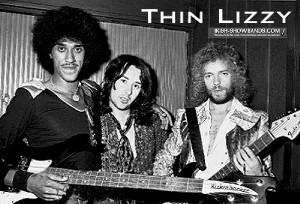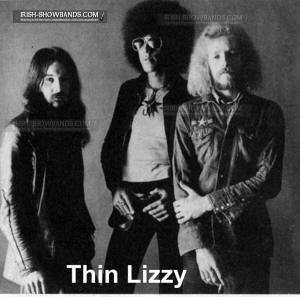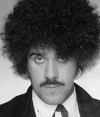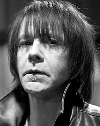Thin Lizzy Feature (1970-1983)
Photo Gallery -
Band Lineups -
Discography
- Audio samples -
Where Are They Now?
The Story
 Obviously, much has been written about the
legendary history of Thin Lizzy, who, along with U2, Van Morrison and
Rory Gallagher are among the most successful Irish rock acts ever. A complete history of the band is well beyond the scope of
the site and its main objective of covering bands that played the
Irish ballroom circuit, but as Lizzy did get their start in the
clubs, ballrooms and schools of Ireland, we
feel we should cover the band, especially the early years.
Obviously, much has been written about the
legendary history of Thin Lizzy, who, along with U2, Van Morrison and
Rory Gallagher are among the most successful Irish rock acts ever. A complete history of the band is well beyond the scope of
the site and its main objective of covering bands that played the
Irish ballroom circuit, but as Lizzy did get their start in the
clubs, ballrooms and schools of Ireland, we
feel we should cover the band, especially the early years.
Thin Lizzy's lead vocalist, songwriter, and
bassist Phil Lynott started singing with the group The
Black Eagles in Dublin around 1965 when he was just 16. However,
his career started in earnest as lead singer
with Brush Shiels' group Skid Row in 1968. Brush had been with the
Up Town Band and broke away to form his own group. Brush has often
suggested that it was during this period that he taught Phil how to
play bass. During his stint with Skid Row, Phil was purely the
lead vocalist and front man and was one of the biggest stars on the
local Dublin beat group scene in the late sixties.
In mid 1969, Phil
left the Skid Row
and formed Orphanage which included Brian Downey (drums), Joe
Alexander (guitar), Pat Quigley and a guest member at times, Terry Woods.
Orphanage was a short lived band as they were
approached by Eric Bell at the end of 1969. In an interview in the
May 24, 1973 issue of Spotlight, Eric recounted how the band got
started. "One night I went down to Belfast with Eric Wrixon (one
time keyboard player with Van Morrison). After a half hour I really
got into listening to the band who were playing - Orphanage." At the
time Eric was looking for a bass player and drummer to form his own
group after leaving the Dreams. After the gig, he approached Phil Lynott, whom he had known previously.
"I kept asking them if they knew any good
drummers, but they were just shaking their heads. There were only
four of us there-Phil Lynott, Brian Downey, Eric Wrixon and myself.
So anyway, I said goodnight and started to walk out but Phil called
me back, just turned to Brian and asked him if he fancied quitting
Orphanage and getting something together with me. It was as sudden
as that," he recalled. "Eric was there so he just assumed he was in
it too." The name "Thin Lizzy" came about when Eric was reading a
Beano or Dandy kid's comic book. "There was a robot bird
in the comic named Tin Lizzy. So we just added a "h" to mess people
about. So that was that," he remembered.
 Pat Egan's "Beat" column
in Spotlight of February 20, 1970 described Thin Lizzy as "Eric
Bell's band" as Eric, who had been lead guitarist with showband
The
Dreams, left them to start a new group and drafted Lynott and Downey
from Orphanage and previously Sugar Shack, along with former member of Them, Eric Wrixon on
keyboards (Eric had also been with Them prior to joining the
Dreams). The band played their first gigs in late February, 1970,
but were not immediately seen as the powerhouse they would become.
Pat Egan's "Beat" column
in Spotlight of February 20, 1970 described Thin Lizzy as "Eric
Bell's band" as Eric, who had been lead guitarist with showband
The
Dreams, left them to start a new group and drafted Lynott and Downey
from Orphanage and previously Sugar Shack, along with former member of Them, Eric Wrixon on
keyboards (Eric had also been with Them prior to joining the
Dreams). The band played their first gigs in late February, 1970,
but were not immediately seen as the powerhouse they would become.
In fact, early reports were that the band was
rather loose and would have to work hard to make it on the Dublin
scene. Slowly, their reputation grew and at one point, Pat Egan
wondered whether they might be the next "Skid Row." In fact, at the
time, Skid Row (Brush Shiels, Noel Bridegman, and Gary Moore) were
far and away the biggest group based in Ireland as Rory Gallagher's
Taste had settled in England sometime earlier. The band toiled away
on the local Dublin scene, refining their sound and were on their
way to establishing themselves as the top group in Ireland when Eric
Wrixon left the band in August to go to Sweden reportedly over a "dispute over music
policy." In a 1974 Spotlight interview, Eric Bell said, "he went off
with some Swedish chick and we were three."
The band decided not to replace their keyboard
player and continued on as a power trio. The band released its first
single in August, 1970, shortly after Eric's departure. The Farmer
(written by Phil Lynott)
was released by Parlophone records in Ireland only and is reported to have
only sold three hundred copies (which was not unusual for Irish rock
group records at that time). The song was recorded in Trend Studios
and sounded more like The Band than what Lizzy would eventually
become.
Shortly after it's release, an article by
Donall Corvin in Spotlight, lamented that, "it has no chance
of getting airplays and a snowball's chance in hell of making the
charts. But so what?" Despite their lack of recording
success, the band's live show went from strength to strength as Phil
continued to develop his "rocker" image which was to carry the group
in the future. They started to travel further a field and regularly
made trips to the four corners of the country to play at teen
dances, student hops and other small gigs (usually for very little
money).
 In October, 1970, a report in Spotlight
magazine said the band was changing management. Terry O'Neill, a
seventeen year old who had been the road manager for Skid Row, had
been managing the band and sold his interest to Peter Bardon and
Brian Tuite. In an August 1974 Spotlight interview Phil said, "I
organised the first group transfer fee in history of Irish groups.
Our manager then was Terry O'Neill and Brian Tuite wanted to manage
us. I arranged for Terry to get £200." Bardon and Tuite had also managed the fortunes of Skid
Row before the relocated to London under manager Clifford Davis.
Probably the most interesting article I have come across was one in
Spotlight magazine dated January 30, 1971 in which is was
reported that Decca Record Manager, Frank Rodgers, announced the
band would be changing its name to Tin Lizzy, dropping the "h." The
move lead to a series of advertisements and publicity sporting the
name Tin Lizzy, but of course, the name did not stick.
In October, 1970, a report in Spotlight
magazine said the band was changing management. Terry O'Neill, a
seventeen year old who had been the road manager for Skid Row, had
been managing the band and sold his interest to Peter Bardon and
Brian Tuite. In an August 1974 Spotlight interview Phil said, "I
organised the first group transfer fee in history of Irish groups.
Our manager then was Terry O'Neill and Brian Tuite wanted to manage
us. I arranged for Terry to get £200." Bardon and Tuite had also managed the fortunes of Skid
Row before the relocated to London under manager Clifford Davis.
Probably the most interesting article I have come across was one in
Spotlight magazine dated January 30, 1971 in which is was
reported that Decca Record Manager, Frank Rodgers, announced the
band would be changing its name to Tin Lizzy, dropping the "h." The
move lead to a series of advertisements and publicity sporting the
name Tin Lizzy, but of course, the name did not stick.
Eric picks up the story, "We fixed a gig in
Zhivago and he came in, real cool, and looking as if he was saying:
Okay impress me! So we weren't really into what we were doing. Then
Ditch Cassidy got up with us to jam and we began to enjoy ourselves
and forget about this cat from London. Next thing we knew, he'd
arranged for us to go to London the following week to record an
album." Once in London, the band was earning £8 a week plus
rent paid. Their operating expenses ran at below £100 a week. Phil
maintained that even on those meager wages they were better off than
they were in Ireland.
Now signed to Decca Records, the band released
an E.P. (four track) single, New Day, and set about
recording their first album. The single did little in terns of sales
or publicity for the band. Their live show was still where it was
all happening for Lizzy. A short time later, they released the album,
Thin Lizzy, which was picked
up by Radio Luxemburg's Kid Jensen, who played it in its entirety
over a handful of nights and that started the ball rolling in
England. The album did not originally contain the four tracks on the
New Day E.P., but they were added on subsequent re-releases. The
band was constantly gigging and started to build a reputation
as a live act, but it was slow going, with the band learning as they
went. They returned to Ireland support to Rory Gallagher in the
Stadium and then to support Slade on their Irish tour.
Explained Eric, "The Slade tour helped us a
lot. Chas Chandler came up and told us he dug the band but that our
clothes weren't colourful enough, so we started to get into that end
of things. After a while the shape throwing became automatic and the
music was all we worried about."
It was late 1972 and the band were still
growing their reputation when they released their second album,
Shades of A Blue Orphanage, which was rushed. Said Eric, "we really weren't that happy with it.
Then at a rehearsal one day we were having a break for a cuppa tea
and Phil started to play Whiskey In The Jar on a Stratocaster
and singing into the mic. Brian and I were just sitting there bored.
Ten minutes later Phil was still going on with this thing, so we
joined in." Although it started out as a joke and a bit of a laugh,
the band's version of the Irish ballad stuck and they released it as
a single, and the rest, as they say, is history. Whiskey in the Jar
became a multi national hit for the band and put them on the musical
map. At the time, they were still playing Irish ballrooms and
hotels.
In 1973, the band completed their album,
Vagabonds of the Western World, on which they included Jan Schelhaus
on keyboards for several of the tracks, as well as using Radio
Luxembourg's Kid Jensen for narration on Hero and the Madman.
 An article in the January 17th, 1974 issue of
Spotlight reported that Gary Moore was standing in for Eric Bell,
who had "collapsed in Belfast on New Year's Eve." Chris Morrison, Lizzy's co-Manager said, "We don't expect to have Eric back on his
feet for at least another fortnight." However, Eric would not
return and had actually quit the band. It was announced on February
14th that Gary Moore would be his replacement. The truth of the
story came out later that Eric had become uninterested in the
band's new "hit single" image. He had gotten drunk earlier in the
day and in the middle of the show, he recounted, "I threw my guitar
in the air, kicked over my amps and walked off the stage and never
came back."
An article in the January 17th, 1974 issue of
Spotlight reported that Gary Moore was standing in for Eric Bell,
who had "collapsed in Belfast on New Year's Eve." Chris Morrison, Lizzy's co-Manager said, "We don't expect to have Eric back on his
feet for at least another fortnight." However, Eric would not
return and had actually quit the band. It was announced on February
14th that Gary Moore would be his replacement. The truth of the
story came out later that Eric had become uninterested in the
band's new "hit single" image. He had gotten drunk earlier in the
day and in the middle of the show, he recounted, "I threw my guitar
in the air, kicked over my amps and walked off the stage and never
came back."
In July, 1974, Desmond Ilford interviewed Phil
Lynott for Spotlight. Eric Bell had left the band at the
beginning of 1974 and had been temporarily replaced by Gary Moore
for the band's first tour in 1974. However, they decided to part
company in May as Gary didn't seem too "into" Lizzy at the time. They hired
two guitarists to replace Gary, but in Phil's words, they were
"really crap." Finally after further auditions, the band added two
new guitarists. Said Phil, "We've picked an 18-year-old Scottish
bloke named Brian Robertson and an American guy called Scott...I
can't remember his last name." The band played its first gig in Wolverhampton in July.
Of course than lineup would go on to conquer the world and Phil
Lynott, Brian Downey, Brian Robertson and Scott Gorham would become
true superstars.
At that point, we feel Thin Lizzy was really no longer
an "Irish" band as they were headquartered in London and
featured two non-Irish guitarists. Although their world wide fame
took off in the mid 1970's with the release of The Boys Are Back
In Town in 1975, it is really beyond the scope of our
website to do justice to the band's history after they broke in the
United States and across the rest of the world. Needless to say, Thin Lizzy's
history as part of the Irish ballroom scene led the way for
more Irish acts to come in the years that followed.
click on thumbnails for full image
 |
Phillip Lynott - RIP:
Of course, Phil continued to be one of Ireland's foremost
figures in rock music internationally, mostly playing with
Thin Lizzy, but also as a solo artist. He featured in Jeff
Wayne's historic War of the Worlds album and also
fronted rock band Grand Slam as well as several
reincarnations of Lizzy. He collaborated with many musicians
including Gary Moore, who had and would again play with
Lizzy during their history. Phil also wrote several books of
poetry and was active until his untimely death on the 4th of
January 1986 at the young age of 36. He remains, along with
Rory Gallagher, one of the most revered names in the history
of Irish rock music.
|
 |
Eric Bell: After
leaving Lizzy, Eric went through several bands including his
own Eric Bell Band and with Skid Row bass player Brush
Shiels in the Bell-Brush Band. In 1974 he joined with ex-Jimi
Hendrix bassist Noel Redding in the Noel Redding Band which
lasted through 1976, recording a couple of albums. During
the last 30 years, Eric has continued to gig and record with
his own Eric Bell Band, playing to large crowds
across the continent and around the world. He appeared with
Gary Moore in 2005 performing Whiskey in the Jar to
an extremely appreciative crowd (a great DVD if you're
interested). |
 |
Brian Downey: An
original member of Lizzy, Brian stayed with Phil through
thick and thin for the next 13 years, playing with all the
various Lizzy lineups as well as with Phil on his solo
efforts. After Phil's death, he played in the tribute Thin
Lizzy line-up with John Sykes, Scott Gorham, Darren Wharton
and Marco Mendoza, but had been absent from subsequent Thin
Lizzy touring bands. In May, 2010, Brian rejoined the Lizzy
lineup and is currently touring with the band (late 2011)
commemorating 25 years since Phil Lynott's death. |
 |
Eric Wrixon: Although
a founder member of the band, he left before they achieved
fame and success. In the years since then, Eric has toured
and is often associated with reunited versions of Them, with
Jim Armstrong, John Wilson, and others. In 2011, he was living in Italy and touring with a line-up including himself
(vocals and keyboards), Billy McCoy (guitars), Luca Nardi
(bass) and Tom Wagener (drums). |
 |
Gary Moore - RIP: After
leaving Lizzy, Gary went solo, forming his own Gary Moore
Band. He would later (1977) reunite with Phil and Lizzy
for a short time. He continued to collaborate with Phil
during the 70s and 80s with their greatest success being the
single Parisienne Walkways which hit the British Top
Ten in 1979. Through the next 30 years, Gary continued to
tour and became one of the premiere blues guitarists in the
world. Sadly he passed away, suffering a heart attack, on
the 6th of February, 2011 at 58 years of age. |
 |
Brian Robertson:
Brian stayed with Lizzy until 1978 when he left and was
replaced by Gary Moore (coincidentally, Brian and Scott had
replaced Gary Moore after the departure of Eric Bell. He
formed the group, Wild Horses which lasted a short
while and then joined Motorhead for a short stint. He
continues to record and tour today, mostly in Europe but was
not part of the Thin Lizzy lineup which was touring in late 2011. |
 |
Scott Gorham: Joining
the band after the departure of Eric Bell, Scott stayed with
the band until it's break up around 1983. He was the longest
serving member of the band other than Brian and Phil. After
Lizzy broke up, Scott joined Phenomena II, where he met Leif
Johansen with whom he formed 21 Guns, which has released
three albums. He also played spells with Asia, the Rollins
Band, and Supertramp. In 1996, Scott reformed Thin Lizzy
with former band members, playing various tours in tribute
to Phil. After John Sykes' departure in 2009, Scott set to
work on creating the greatest lineup of Thin Lizzy since
Phil's passing. Rejoining him are old band mates Brian
Downey and Darren Wharton. |
| |
Many other band members
came and went in the late 70's and 1980's including Darren
Wharton, Snowy White, John Sykes, Midge Ure, etc. but as
none of them were involved with the band which toured
Ireland so extensively, we have omitted them from the site.
|
